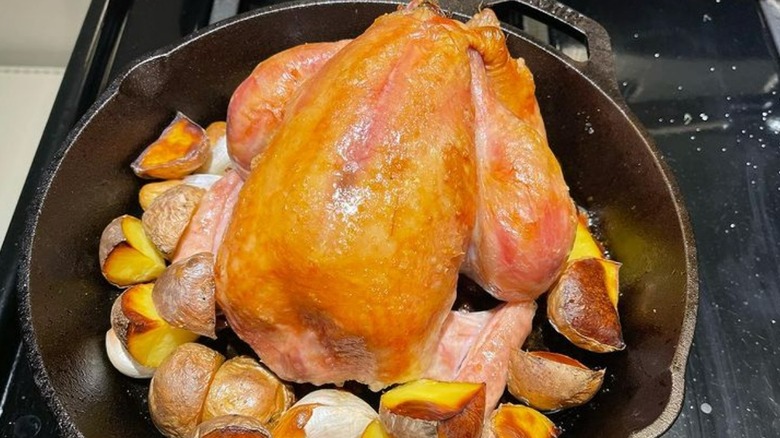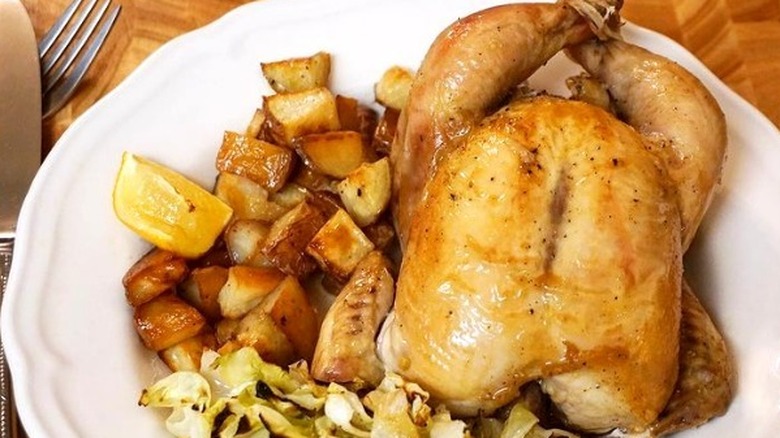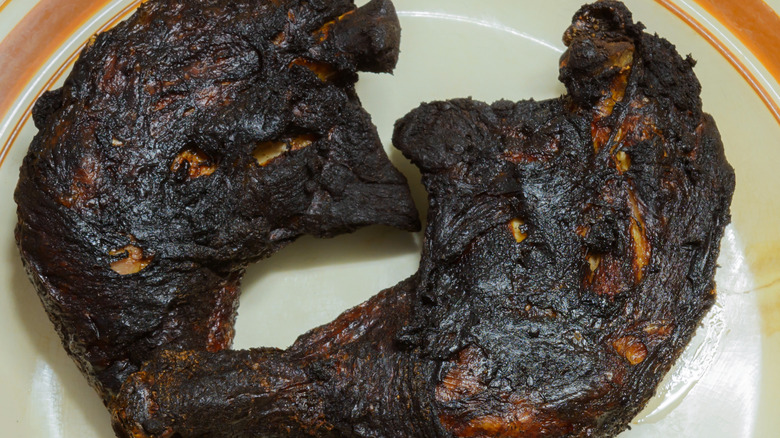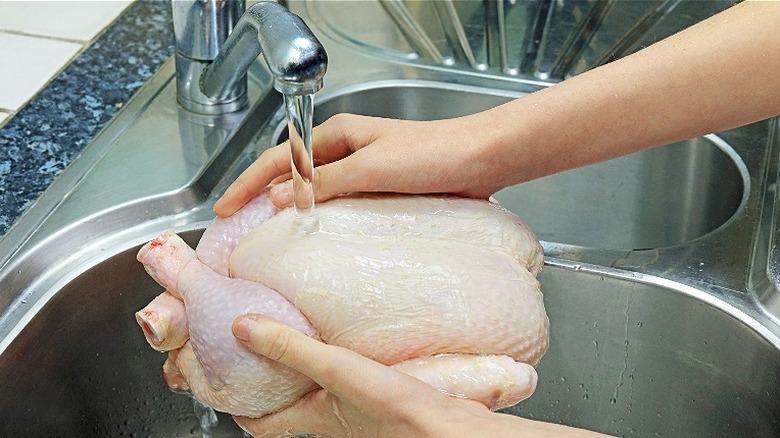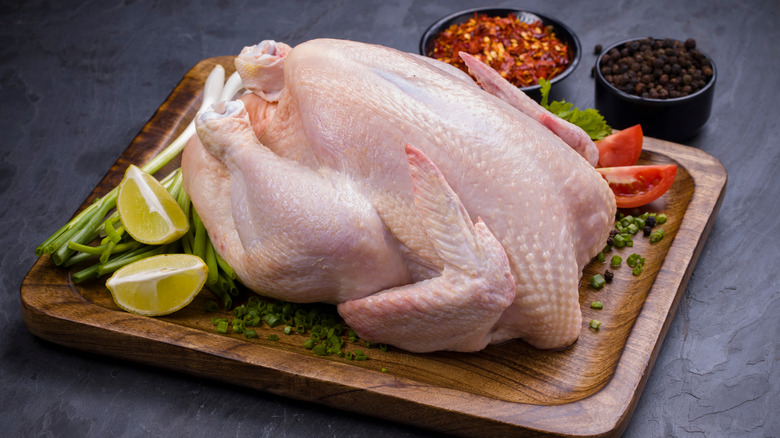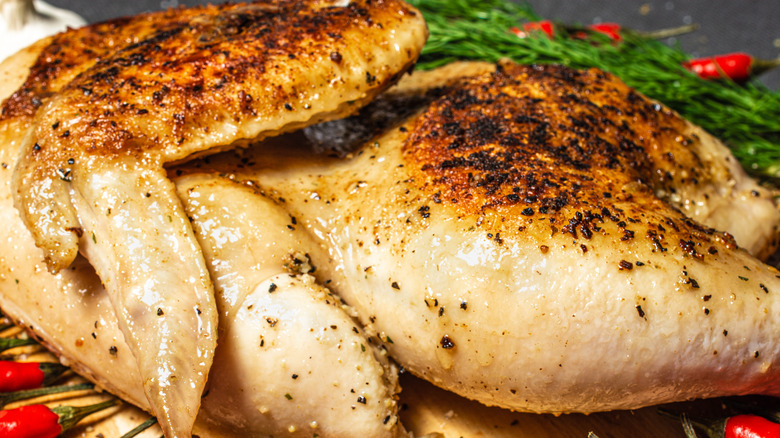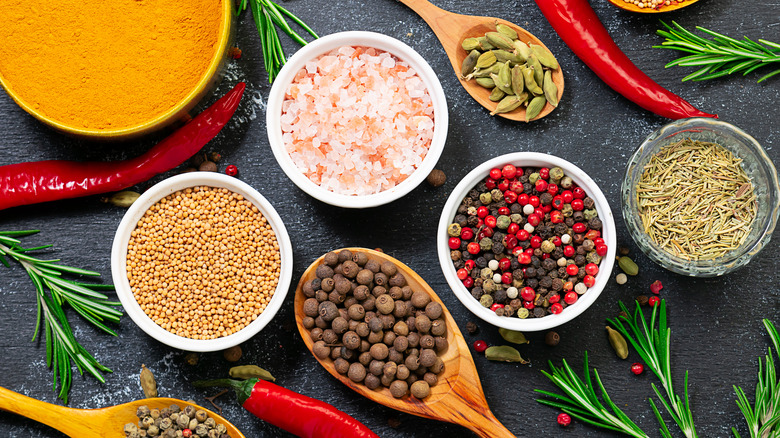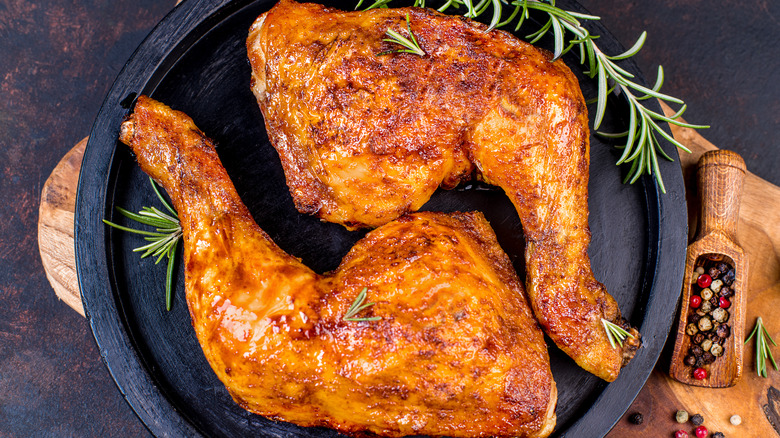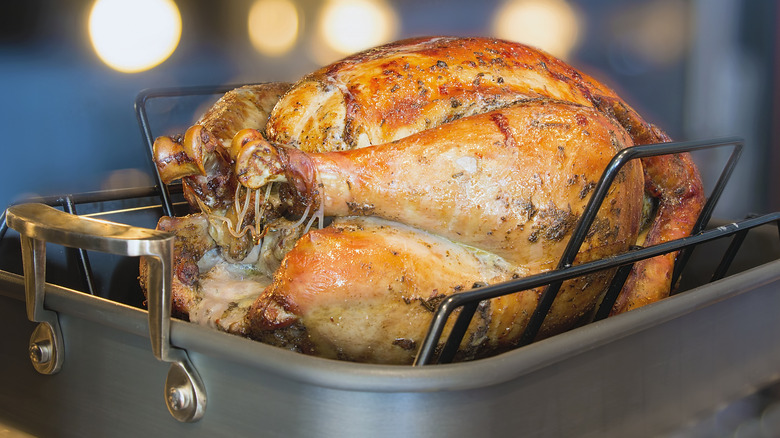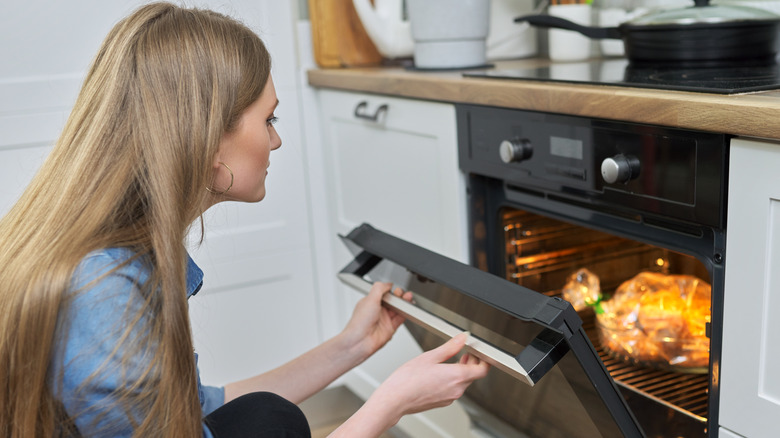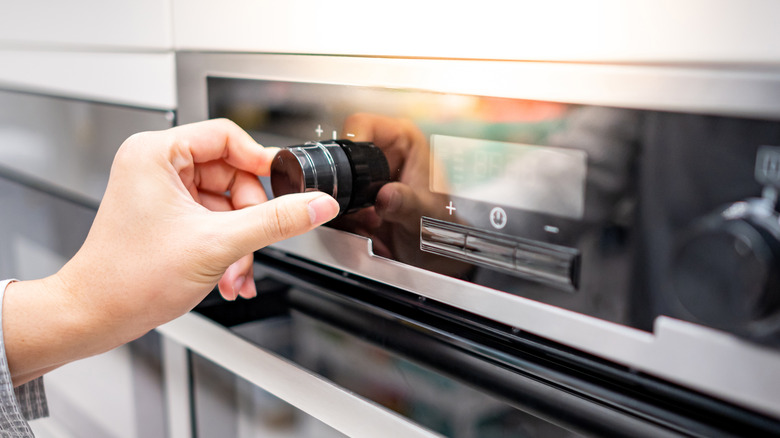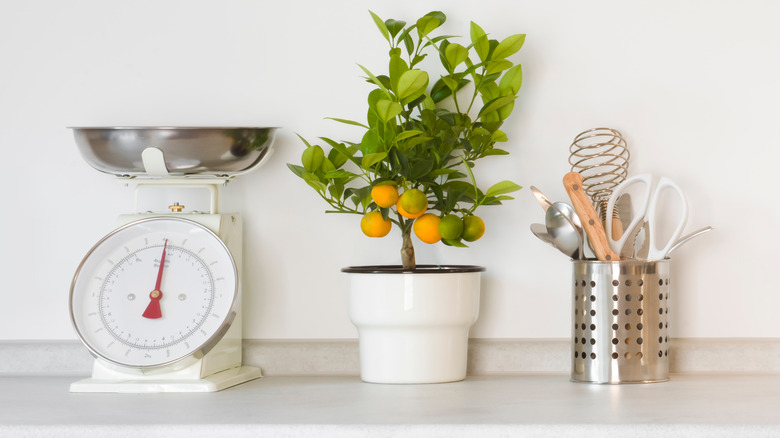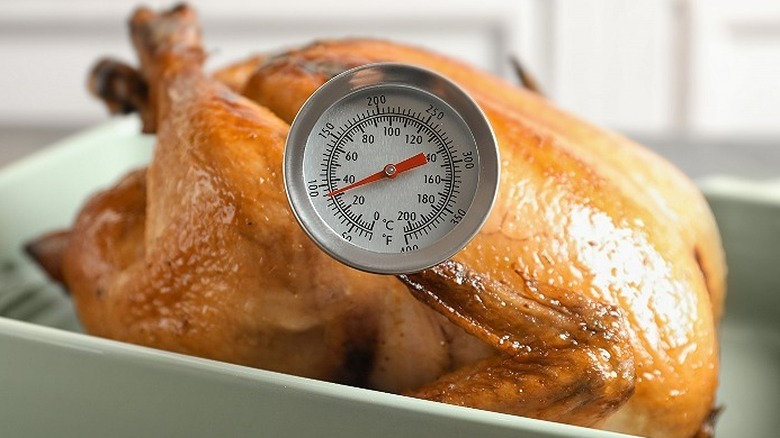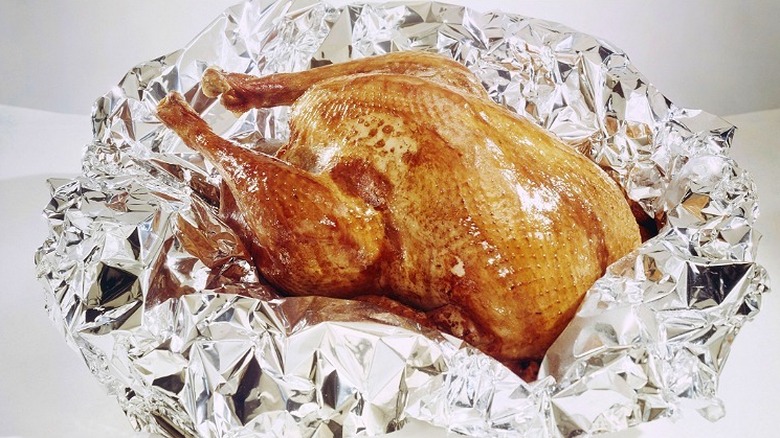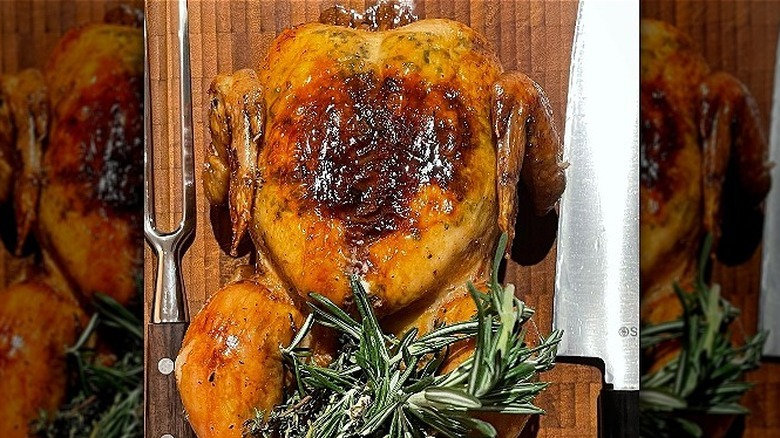Mistakes Everyone Makes When Roasting Chicken
A fresh-out-of-the-oven roasted chicken with a reddish-brown hue of crisp skin surrounding tender, succulent meat is the kind of image food magazines go wild for. It's an image of pure, simple, unadulterated comfort food — every bite just warms you up, inside and out.
However, this seemingly uncomplicated, wholesome dish can be far more complex than one might give it credit for. There are plenty of recipes out there for how to make "the perfect roast chicken." However, many of them fail to take into account that without the right tools, techniques, and sense of timing, your beautiful roast could end up burned, underdone, overdone, or swimming in grease. In the end, you may be left hungry and without a meal.
Before you break out the herbs and spices and learn what "spatchcock" means, make sure you're avoiding these very common yet very grievous mistakes when it comes to making the perfect chicken roast.
Not choosing the right chicken
Even at the grocery store, the kind of chicken you purchase plays a big role in how it comes out when roasted. While you can go frozen, the freezing process does take some of the moisture out of the chicken — moisture that you won't get back. If possible, try to go for an unfrozen chicken. As always, the fewer steps it takes to get from the farm to your grocer, the better quality it will be. When selecting the right chicken, Canadian Living advises approaching it as you would when looking for good produce. Look at how much meat is on the chicken, try to check if the skin feels smooth, and even give it a whiff to see if it's fresh. If it smells funky or looks seems to be a color that chicken' shouldn't be, steer clear.
If there is one type of chicken that is made for roasting, it would be the Cornish hen. It's not too big — about 1 to 2 pounds each — and they're younger chickens, meaning the meat is fresher. If you've never made roast chicken before, this would be the best place to start.
Giving your chicken zero prep time before cooking
Just look at that burnt bird in the photo above, yikes! Trying to roast your chicken before it's had a chance to thaw is a fast way to end up ordering a pizza for dinner. Instead of a beautiful roast, you'll end up with dry, possibly burned skin covering meat that's still very raw. Before you even set your oven, make sure that your chicken has thawed and brought itself to room temperature, per The Jersey Cook.
Properly resting your chicken only takes the simple application of time. If your chicken is frozen, leaving it in the fridge overnight will begin the defrosting process. After defrosting, leave it out in the open for around three hours to bring it to room temperature.
Not only will it help evenly cook the chicken, but it will also make sure the juices aren't squeezed out by the heat from the oven. Keeping them inside ensures the roasted chicken meat stays juicy and tender.
Washing the chicken
It turns out that washing chicken in the sink doesn't remove the bacteria. Sounds totally counterintuitive, doesn't it? Believe it or not, it might make the situation worse, as it could turn your kitchen sink into a petri dish, per WebMD. In the end, it could take some serious sanitation to remove bacteria before it spreads. While it does seem to go against our natural inclination to sanitize our food before cooking, the best thing you can do for your chicken is leave it alone until it's ready for the oven.
If it makes you feel better, you'll still be fully sanitizing your chicken, as you'll quite literally be cooking germs right off the meat. If you need further evidence, a report from the U.S. Department of Agriculture states that washing raw chicken in your sink has a 60% chance of transferring bacteria from the meat to other surfaces, and a 26% chance of transferring from contaminated surfaces to other foods.
Trying to cook a wet chicken
Now we said don't wash your chicken, but we didn't say not to dry it, did we? If you're really shooting for that classic crisp "tap it with a fork" skin on your roast chicken, make sure you've allowed the moisture on the bird's skin to dry out. You can also use paper towels to further pat the chicken dry, according to Chatelaine, ensuring there's as little water as possible on the skin before cooking. Removing the excess water off of your chicken gives the skin a better shot at crisping up once most of its moisture has steamed off in the oven.
Too much water on the skin means more moisture will be turned into steam while it's cooking. In turn, that may mean your chicken's skin won't effectively caramelize the way you want. In fact, you might end up with more soggy, soupy chicken if it's not fully dried. If you've decided to marinate your chicken, there's no issue to be had, as it's more about reducing the marinade while the chicken cooks. If you really want the reddish-golden color, though, make sure it's as dry as it can be.
Using too much oil
A generous application of olive or vegetable oil to make a roast chicken might seem like it makes sense, but it's possible to have too much of a good thing. That's because your chicken has all of the fat it will ever need, right inside. A drizzle of oil on the top can help bring a little extra flavor to the roast, especially the skin, according to The Kitchn. However, much like needing to pad it dry, too much oil can create a similar problem — your roast may come out too oily and greasy. If you're shooting for crisper skin, you're only going to make things more difficult.
If you're going to apply any oil to your roast chicken, do so sparingly. Remember, the fat inside the chicken will render inside and outside of the bird. If you're really shooting for that crisp skin, make sure you don't make this mistake, nor the next one.
Not bothering to season
Poultry is one of those versatile kinds of meats that absorbs other flavors like a champ. While there is the inclination to just add some salt and pepper to your roast chicken, consider developing a spice mix just for your roast to make your dish more aromatic and all-around more delicious. Pepper and salt are a good start, but there is a wide assortment of herbs and spices that can complement one another, per Diethood. Cayenne pepper can add just the right bit of heat, whereas herbs like thyme, basil, sage, and rosemary can add a burst of aromatics as well as depth of flavor. Parsley can brighten up chicken, giving it a cleaner taste, while garlic and onion powder can add extra dimensions without overpowering the chicken itself.
A well seasoned roast chicken can have almost countless combinations of herbs and spices. This might be the only time you can try experimenting to see which combination works with your palate.
Concentrating only on the legs or breast
Unless you've already segmented what choice cuts of meat you want, traditionally, a roast chicken is cooked whole. To make matters a bit more difficult, both white and dark meat cook at different temps and finish at different times. A classic issue with roast chicken is that trying to cook through one part often means sacrificing another. If you're interested in a tender chicken breast, get ready for chewy, undercooked legs. If drumsticks and pinwheels are your things, be prepared for a dried-out breast. However, there's a tried-and-true secret to achieving nearly total roasting symmetry to get everything cooked through at the same time.
An overnight salt water brine before cooking is a great way to season your chicken thoroughly and make sure everything cooks evenly, per MasterClass. The salted water helps trap the moisture inside the chicken, making sure the water stays inside and keeps the breast from drying out while helping the dark meat cook thoroughly.
Not using a roasting pan with a rack
A beloved method of cooking chicken is the classic rotisserie method. The slow rotation of the chicken over steady heat allows the rendered fat from the chicken to self-baste while it cooks evenly. However, not many of us have the time, the equipment, or the oven space to watch a chicken rotate for hours at a time. Luckily, a proper roasting pan with a rack creates similar results as a rotisserie and is a simple yet wonderfully useful cooking vessel, per Overstock. It makes sure your roast chicken is basting — not drowning — in its own juices.
The wire rack, in particular, creates a bit of space between the chicken and roasting pan to capture drippings. This helps make sure that when it's ready, you'll be tasting more of that clean, roast chicken flavor that's been lightly basted in rendered fat, as opposed to being boiled in a stagnant coagulating pool. Also, for the health-conscious, all of the fat dripped off of the chicken means you'll consume less fat.
Not considering where the chicken goes in the oven
This might come off as persnickety, but understanding where your chicken goes in the oven and what kind you have is important to perfecting the art of the roast. When using a conventional oven, remember that the heat rises upward. Placing your chicken on too high of a rack may mean it won't get enough heat. On the other end, placing it close to the bottom is an easy way to end up with overdone or a burned rost. As an all-around rule, the best place to put your chicken is right in the middle on the center rack of a conventional oven, according to Cook For Folks.
If you happen to have one of those convection ovens, where you place your chicken really won't matter, as the oven will circulate the heat and help cook it evenly. However, it's a good idea to drop the heat by at least 25 degrees. This is because a convection oven does so well with circulating heat that using it might overcook your chicken.
Cooking on high heat with less time
Perhaps the greatest enemy of all good cooking is impatience, and roast chicken is an excellent example of the principle. It demands a slow and considered approach to cooking, and most certainly this can be found when setting the right time and temperature, according to The Splendid Table. Even "faster" roast chicken recipes that recommend higher heat with less time rarely if ever set the timer for under an hour. As a rule, the more time you give a chicken in the oven with less heat, the better the final product will be. There's only a 125-degree ballpark between low and high heat for the ideal roasting temp, as slow-roasted chicken cooks at 350 degrees Fahrenheit, according to Food Network. A roast with a more succulent flavor runs as high as 475 degrees Fahrenheit.
Rushing at this crucial stage can leave your roast burned on the outside, raw on the inside, or completely dried out. When you need to set the right time, make sure you don't make the next mistake.
Not cooking by weight
Timing is everything when it comes to making the perfect roast chicken, and even the best recipes can't take into account just how much time your store-bought chicken will take to be done. Roast chicken, in particular, sits on that knife's edge between underdone or overdone. The most effective method for determining just how long your chicken should cook is to measure the time by weight. Smaller chickens can take less time and can quickly cook through at a higher heat, per BBC Good Food. In contrast, larger birds will take more time with a lower temp. Also, be sure to check your chicken when it gets close to the time it's supposed to be done. Chances are it can be taken out early and can finish cooking outside of the oven.
Remember, a roast chicken recipe can give you an estimation as to how long it will take. By knowing the exact weight of your bird, you can add or subtract time as needed to achieve the right amount of "doneness."
Not checking the internal temperature
Aside from measuring the time and heat inside of the oven, the single most important factor to measure in a roast chicken is its internal temperature. This isn't just a factor of flavor or doneness — when cooked at too low of a temperature or for a limited amount of time, any bacteria nesting in the chicken meat won't die off during cooking. The absolute best way to measure true, safe doneness is with a meat thermometer. After the allotted time has passed, insert the thermometer into the thickest part of the chicken without touching the bone. This will provide you with the most accurate reading as you'll see if your roast is really cooked through.
Keep in mind that different parts of the chicken are done at different temperatures. For instance, the white meat of the chicken breast is typically ready to eat after reaching 165 degrees Fahrenheit, while dark meat found in the drumsticks needs to be between 175-180 degrees Fahrenheit.
Not covering your chicken in the oven
This mistake might not ruin your roast chicken, but it does leave you with an oven that's in desperate need of a cleaning. While it's cooking, not only does all of that chicken fat render, but moisture inside of the poultry turns into steam. Naturally, hot oil and water don't mix well, which leads to some sizzling and splattering in your oven. This can also become a more serious problem if the hot fat hits the bottom of your oven, causing it to burn and smoke. If left uncleaned, a greasy oven can become a major fire hazard.
To save yourself some future headaches, as well as your knees and elbows, there are a lot of different tools and tips to prevent oven splatter. While aluminum foil is a popular go-to, also consider a roaster with high sides or a Dutch oven with a cover. One great trick involves heavily lining the bottom of your roasting pan with vegetables, which will absorb all of the chicken fat and can be served as a side dish that's bound to impress.
Carving right out of the oven
If you've done everything right and you've avoided every possible mistake, you may now be pulling out a beautiful golden brown roast chicken suitable for a magazine cover. However, you can still totally botch the endgame with one simple misstep, so watch out! Putting the carving knife into the chicken when it's fresh from the oven will be like popping a water balloon — all of the moisture will quickly leak out and pool in the pan, ultimately leaving you with a dried-out chicken floating on its own island, according to EatingWell. After all that hard work, this is certainly a mistake that nobody wants to get tripped up on.
Again, in this situation, it pays to be patient. Once out of the oven, give your roast chicken at least 10-15 minutes sitting out in the open. Yes, its aroma might be very tempting, but that little bit of extra time allows the moisture inside to cool and settle inside the meat, only coming out when you give it that first bite.
